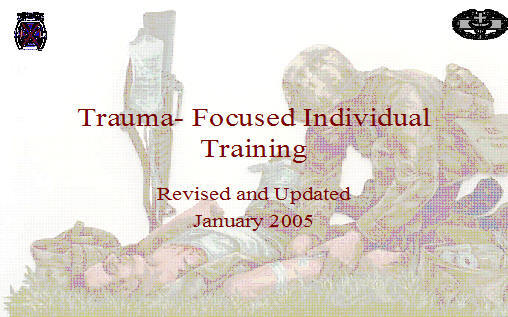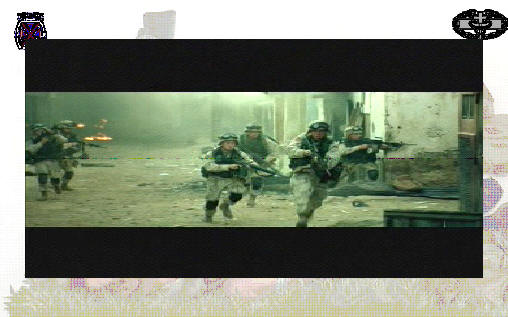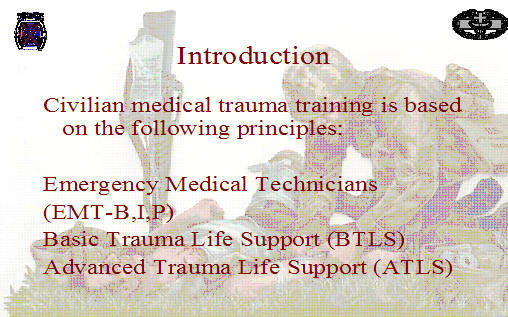Trauma- Focused Individual Training
Click here to download the presentation.



Trauma- Focused Individual Training
Revised and Updated
January 2005
Trauma Focused Individual Training
“T-FIT”
Instructor Name:
Title:
Unit:
Introduction
Soldiers continue to die on today’s battlefield just as they did during the Civil War. The standards of care applied to the battlefield have always been based on civilian care principals. These principals while appropriate for the civilian community often do not apply to care on the battlefield.
Introduction
Civilian medical trauma training is based on the following principles:
Emergency Medical Technicians
(EMT-B,I,P)
Basic Trauma Life Support (BTLS)
Advanced Trauma Life Support (ATLS)
Introduction
Tactical Combat Casualty Care has been approved by the American College of Surgeons and National Association of EMTs and is included in the Pre-hospital Trauma Life Support manual 5th edition.
Introduction
Three goals of TCCC
1. Treat the casualty
2. Prevent additional casualties
3. Complete the mission
Introduction
This approach recognizes a particularly important principle –
Performing the correct intervention at the correct time in the continuum of combat care. A medically correct intervention performed at the wrong time in combat may lead to further casualties
Introduction
Pre-hospital care continues to be critically important
Up to 90% of all combat deaths occur before a casualty reaches a Medical Treatment Facility (MTF)
Penetrating vs. Blunt trauma
Factors influencing combat casualty care
Enemy Fire
Medical Equipment Limitations
Widely Variable Evacuation Time
Factors influencing combat casualty care
Tactical Considerations
Casualty Transportation
STAGES OF CARE
Care Under Fire
Tactical Field Care
Combat Casualty Evacuation Care
Care Under Fire
“Care under fire” is the care rendered by the medic at the scene of the injury while he and the casualty are still under effective hostile fire. Available medical equipment is limited to that carried by the soldier or the medic in his aid bag.
Tactical Field Care
“Tactical Field Care” is the care rendered by the medic once he and the casualty are no longer under effective hostile fire. It also applies to situations in which an injury has occurred, but there has been no hostile fire. Available medical equipment is still limited to that carried into the field by medical personnel. Time to evacuation to a MTF may vary considerably.
Combat Casualty Evacuation Care
“Combat Casualty Evacuation Care” is the care rendered once the casualty has been picked up by an aircraft, vehicle or boat. Additional medical personnel and equipment may have been pre-staged and available at this stage of casualty management.
Care Under Fire
Care Under Fire
Medical personnel’s firepower may be essential in obtaining tactical fire superiority. Attention to suppression of hostile fire may minimize the risk of injury to personnel and minimize additional injury to previously injured soldiers.
Care Under Fire
Personnel may need to assist in returning fire instead of stopping to care for casualties
Wounded soldiers who are unable to fight should lay flat and motionless if no cover is available or move as quickly as possible to any nearby cover
Care Under Fire
Medical personnel are limited and if injured no other medical personnel may be available until the time of extraction during the CASEVAC phase
No immediate management of the airway is necessary at this time due to movement of the casualty to cover
Care Under Fire
Control of hemorrhage is important since injury to a major vessel can result in hypovolemic shock in a short time frame
Over 2500 deaths occurred in Viet Nam secondary to hemorrhage from extremity wounds
Care Under Fire
Use of temporary tourniquets to stop the bleeding is essential in these types of casualties
Tourniquet
Care Under Fire
The need for immediate access to a tourniquet in such situations makes it clear that all soldiers on combat missions have a suitable tourniquet readily available at a standard location on their battle gear and be trained in its use.
Combat Application Tourniquet
Care Under Fire
Penetrating neck injuries do not require C-spine immobilization. Other neck injuries, such as falls over 15 feet, fast-roping injuries, or MVAs may require C-spine control unless the danger of hostile fire constitutes a greater threat in the judgment of the medic
Care Under Fire
Conventional litters may not be available for movement of casualties. Consider alternate methods to move casualties such as a SKED� or Talon II� litter. Smoke, CS, and vehicles may act as screens to assist in casualty movement.
Care Under Fire
Do not attempt to salvage a casualty’s rucksack, unless it contains items critical to the mission
Take the patient’s weapon and ammunition if possible to prevent the enemy from using it against you.
KEY POINTS
Return fire as directed or required
The casualty(s) should also return fire if able
Try to keep yourself from being shot
Try to keep the casualty from sustaining any additional wounds
Airway management is generally best deferred until the Tactical Field Care phase
Stop any life threatening hemorrhage with a tourniquet
Reassure the casualty
Tactical Field Care
Tactical Field Care
The Tactical Field Care phase is distinguished from the Care Under Fire phase by having more time available to provide care and a reduced level of hazard from hostile fire. The times available to render care may be quite variable.
Tactical Field Care
In some cases, tactical field care may consist of rapid treatment of wounds with the expectation of a re-engagement of hostile fire at any moment. In some circumstances there may be ample time to render whatever care is available in the field. The time to evacuation may be quite variable from 30 minutes to several hours.
Tactical Field Care
If a victim of a blast or penetrating injury is found without a pulse, respirations, or other signs of life,
Do Not attempt CPR
Casualties with altered mental status should be disarmed immediately, both weapons and grenades
Tactical Field Care
Initial assessment consists of
Airway
Breathing
Circulation
Tactical Field Care Airway
Open the airway with a jaw thrust maneuver, if unconscious insert a nasopharyngeal airway or Combitube, and place the casualty in the recovery position
Nasopharyngeal Airway
Tactical Field Care
Airway
If the casualty is unconscious with an obstructed airway, perform a surgical cricothyroidotomy
Tactical Field Care
Airway
Oxygen is usually not available in this phase of care
Tactical Field Care
Breathing
Traumatic chest wall defects should be closed with an occlusive dressing without regard to venting one side of the dressing or use an “Asherman Chest Seal�”. Place the casualty in the sitting position if possible.
“Asherman Chest Seal”
Tactical Field Care Breathing
Progressive respiratory distress secondary to a unilateral penetrating chest trauma should be considered a tension pneumothorax and decompressed with a 14 gauge needle
Tension pneumothorax is the 2nd leading cause of preventable death on the battlefield
Tension Pneumothorax
Needle Chest Decompression
Tactical Field Care
Bleeding
Any bleeding site not previously controlled should now be addressed. Only the absolute minimum of clothing should be removed.
Tactical Field Care
Bleeding cont’d
Significant bleeding should be controlled using a tourniquet as described previously.
Once the tactical situation permits, consideration should be given to loosening the tourniquet and using direct pressure or hemostatic dressings (HemCon�) or hemostatic powder (QuikClot�) to control any additional hemorrhage
Chitosan Hemostatic Dressing
Hold the foil over-pouch so that instructions can be read. Identify unsealed edges at the top of the over-pouch
Chitosan Hemostatic Dressing
Peel open over-pouch by pulling the unsealed edges apart
Chitosan Hemostatic Dressing
Trap dressing between bottom foil and non-absorbable green/black polyester backing with your hand and thumb
Chitosan Hemostatic Dressing
Hold dressing by the non-absorbable polyester backing and discard the foil over-pouch. Hands must be dry to prevent dressing from sticking to hands.
Chitosan Hemostatic Dressing
Chitosan Hemostatic Dressing
Place the light colored sponge portion of the dressing directly to the wound area with the most severe bleeding. Apply pressure for 2 minutes or until the dressing adheres and bleeding stops. Once applied and in contact with the blood and other fluids, the dressing cannot be repositioned.
A new dressing should be applied to other exposed bleeding sites Each new dressing must be in contact with tissue where bleeding is heaviest. Care must be taken to avoid contact with the patient’s eyes.
Chitosan Hemostatic Dressing
If dressing is not effective in stopping bleeding after 4 minutes, remove original and apply a new dressing. Additional dressings cannot be applied over ineffective dressing
Apply a battle dressing/bandage to secure hemostatic dressing in place
Hemostatic dressings should only be removed by responsible persons after evacuation to the next level of care
Tactical Field Care
IV
IV access must be gained next. The use of a single 18 gauge catheter is recommended, because of the ease of starting and also helps to conserve supplies.
A Heparin or saline lock-type access tubing should be used unless the patient needs immediate resuscitation.
Saline Lock
Saline Lock
Saline Lock
Saline Lock
Saline Lock
Tactical Field Care
IV
Medics should insure the IV is not started distal to a significant wound.
If unable to start an IV consideration should be given to starting a sternal I/O line to provide fluids
Tactical Field Care
Fluids
1000ml of Ringers Lactate (2.4lbs) will expand the intravascular volume by 250ml within 1 hour
500ml of 6% Hetastarch (trade name Hextend�, weighs 1.3lbs) will expand the intravascular volume by 800ml within 1 hour, and will sustain this expansion for 8 hours
Tactical Field Care
Fluids
Algorithm for fluid resuscitation
BP verses palpable radial pulse and mentation
Superficial wounds (>50% injured); no immediate IV fluids needed. Oral fluids should be encouraged.
Tactical Field Care
Fluids
Any significant extremity or truncal wound ( neck, chest, abdomen, pelvis)
1. If the soldier is coherent and has a palpable radial pulse, start a saline lock, hold fluids and reevaluate as frequently as the situation permits
Tactical Field Care
Fluids
2. Significant blood loss from any wound, and the soldier has no radial pulse or is not coherent–STOP THE BLEEDING– by whatever means available- tourniquet, direct pressure, hemostatic dressings, or hemostatic powder etc. Start 500ml of Hextend�. If mental status improves and radial pulse returns, maintain saline lock and hold fluids
Tactical Field Care
Fluids
3. If no response is seen give an additional 500ml of Hextend� and monitor vital signs. If no response is seen after 1000ml of Hextend�, consider triaging supplies and attention to more salvageable casualties
Tactical Field Care
Fluids
4. Because of coagulation concerns, no casualty should receive more than 1000 ml of Hextend�.
Tactical Field Care
Wounds
Dress wounds to prevent further contamination and help hemostasis
(Emergency Trauma Dressing�)
Check for additional wounds (exit)
Tactical Field Care
Pain Control
Able to fight
Bextra� 50 mg po qd
Acetaminophen 1000 mg po q6hr
Unable to fight
Morphine 5 mg IV / IO
Phenergan� 25mg IV, IM
Combat Pill Pack
Tactical Field Care
Pain Control
Pain control should be achieved by intravenous morphine, if possible
1. 5mg IV morphine may be given every 10 minutes until adequate pain control is achieved. If a saline lock is used it should be flushed with 5ml of sterile solution (saline, LR etc.) after morphine administration.
Tactical Field Care
Pain control
2. Insure some visible indication of time and amount of morphine given.
3. Soldiers who administer morphine should also be trained in its side effects and in the use of Naloxone
Tactical Field Care
Pain Control
Soldiers should avoid aspirin and other nonsteroidal anti-inflammatory medicines while in a combat zone because of detrimental effects on hemostasis.
Tactical Field Care
Fractures
Splint fractures as circumstances allow, insuring pulse, motor, and sensory checks before and after splinting
Tactical Field Care
Antibiotics
Antibiotics should be considered in any wound sustained on the battlefield.
Tactical Field Care
Casualties who are awake and alert, Gatifloxacin 400 mg, one tablet Q day with increased fluids
Casualties who are unconscious, Cefotetan 2gms IV push over 3-5 minutes, may be repeated at 12 hour intervals.
Personnel with allergies to Fluoroquinolones or Cephalosporins, consider other broad spectrum antibiotics in the planning phase.
Casevac Care
Casevac Care
At some point in the operation the casualty will be scheduled for evacuation. Time to evacuation may be quite variable from minutes to hours.
Casevac
Casevac Care
There are only minor differences in care when progressing from the Tactical Field Care phase to the Casevac phase.
1. Additional medical personnel may accompany the evacuation asset and assist the medic on the ground. This may be important for the following reasons:
Casevac Care
The medic may be among the casualties
The medic may be dehydrated, hypothermic, or otherwise debilitated
Casevac Care
The Evac asset’s medical equipment may need to be prepared prior to evacuation.
There may be multiple casualties that exceed the capability of the medic to care for simultaneously.
Casevac Care
2. Additional medical equipment can be brought in with the EVAC asset to augment the equipment the medic already has.
This equipment may include:
Casevac Care
Electronic monitoring equipment capable of measuring a patient’s blood pressure, pulse, and pulse oximetry.
Oxygen should be available during this phase
Casevac Care
Ringers Lactate at a rate of 250ml per hour for patients not in shock should help to reverse dehydration.
Blood products may be available during this phase of care.
Summary
How people die in ground combat:
31% Penetrating Head Trauma
25% Surgically Uncorrectable Torso
Trauma
10% Potentially Correctable Surgical Trauma
Summary
9% Exsanguination from Extremity Wounds 1st
7% Mutilating Blast Trauma
5% Tension Pneumothorax 2nd
1% Airway Problems 3rd
12% Died of Wounds (Mostly infections and complications of shock)
Today < 5 %
Summary
Three categories of casualties on the battlefield
Soldiers who will do well regardless of what we do for them
Soldiers who are going to die regardless of what we do for them
Soldiers who will die if we do not do something for them Now (7-15%)
Summary
If during the next war you could do only two things, (1) put a tourniquet on and (2) relieve a tension pneumothorax then you can probably save between 70 and 90 percent of all the preventable deaths on the battlefield. COL Ron Bellamy
Summary
Medical care during combat differs significantly from the care provided in the civilian community. New concepts in hemorrhage control, fluid resuscitation, analgesia, and antibiotics are important steps in providing the best possible care to our combat soldiers.
Summary
These timely interventions will be the mainstay in decreasing the number of combat fatalities on the battlefield.
National Stock Numbers
One handed tourniquet 6515-01-504-0827
Hextend� Fluid 6505-01-498-8636
FAST 1� 6515-01-453-0960
Emergency Trauma Dressing� 6510-01-492-2275
HemCon Chitosan Dressing� 6510-01-502-6938
Sked Litter� 6530-01-260-1222
Talon II Litter� 6530-01-452-1651
QUESTIONS ??